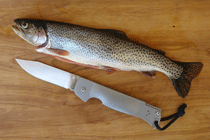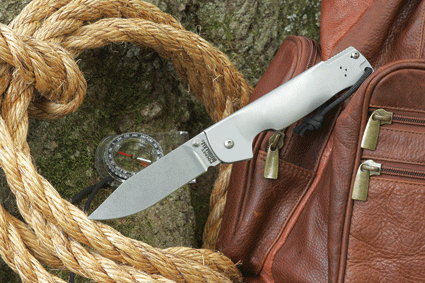A few years ago Cold Steel Knives introduced a one piece, all-metal knife called the “Bushman.” Like many common agricultural tools in the third world, the fixed blade featured a welded seam, steel tube handle. You can’t get much simpler if you are trying to make tough but economical implements for backwoods subsistence farmers. As it turns out, it works equally well for producing very-low-cost knives.
 What has really impressed me is the great acceptance of these basic knives by the real-world jungle experts of South America and Africa. More than once I’ve been told of Americans leaving both expensive “survival” knives and CS Bushman blades behind with the local villagers in the jungle. When they went back some time later they found only the Cold Steel Bushmans were still in everyday service, while the more expensive knives had been tossed in a corner somewhere.
What has really impressed me is the great acceptance of these basic knives by the real-world jungle experts of South America and Africa. More than once I’ve been told of Americans leaving both expensive “survival” knives and CS Bushman blades behind with the local villagers in the jungle. When they went back some time later they found only the Cold Steel Bushmans were still in everyday service, while the more expensive knives had been tossed in a corner somewhere.
African Safari Use
One of the game trackers Cold Steel’s Lynn Thompson has used during his hunts in South Africa has skinned dozens of head of big game with a Bushman. Cold Steel had this Bushman on display at the 2008 SHOT Show, and other than a little wear on the finish, it looked good as new. I’ve hunted with Thompson’s tracker and know, for a fact, he has a wide variety of knives available to him. Nevertheless, the Bushman is what he prefers.
Advertisement — Continue Reading Below
The French Connection
Designing a folding knife to fit into this class of tough-as-nails, low-cost cutlery would seem like a challenging project, but Cold Steel has succeeded with their new “Pocket Bushman.” Cold Steel states part of the concept for the Pocket Bushman came from the traditional French “Douk Douk” folder. Originally introduced in the 1920’s, the Douk Douk—a Douk Douk was a Polynesian sorcerer; an image of the witch doctor and several other themes were stamped on the handles of the knives—was created by the French company of Gaston Cognet as a low-cost folding knife to be used as a trade item in that country’s former colonies. It seems to have been especially popular in Northern Africa. In his book St. Michael and the Dragon, French paratrooper Pierre Leulliette stated that many French Algerians lived in fear of having their throats cut by a Douk Douk-armed insurgent lurking in the dark. I’ve also been told the French banned export of Douk Douks to Algeria during this period.
The basic merit of the Douk Douk is the folded, one-piece (including the back spring) sheet metal handle that was pioneered by several German cutlery companies around the end of the 19th century. This allows the knives to be stamped out very quickly and inexpensively on automated machinery. The plain carbon-steel blades of the Douk Douk also had a reputation for being of excellent quality, but given their low Rockwell, around Rc 50-52, I suspect this was simply because they were easy to resharpen. I don’t know if Cognet still exports the knives to Africa but I do know you can still find the Douk Douk for sale in cutlery shops in Paris.
Pocket Bushman Features
Other than having a folded sheet-metal handle, Cold Steel’s knife has only a limited similarity to the Douk Douk. The Pocket Bushman features a 5.75-inch handle of 420 stainless with a 4.5-inch clip-point blade of Krupp 4116 stainless steel. Like the Douk Douk, the CS knife is very flat, 3.5mm to be exact. Unlike the French knife, the CS version locks open with the new Andrew Demko designed “Ram Safe” system. It’s a little hard to describe how this lock works, but a “self-adjusting ram” moves straight forward as the blade is opened and wedges itself tightly between the tang and the roof of the knife handle. One word of caution here, keep the web of your hand out of the way when that lock is snapping forward as it has a tendency to pinch if you’re not careful. To unlock the blade, the user pulls back on a nylon cord tied to a lanyard hole on the end of the lock bar. The suggested retail price of the knife is $39.95.
Advertisement — Continue Reading Below
While the knife does have ambidextrous thumb-studs on the blade, I really can’t recommend it as convenient one-hand opener or closer. Think of this as a heavy-duty cutting tool that you are going to deliberately open and have all the time in the world to close. After all, that deer usually isn’t going anywhere by the time your knife comes out of a pocket. Web commandos will just have to look elsewhere for their cutlery.
It can also be pointed out that a 4.5-inch blade exceeds the legal length for urban carry in many areas. I say “urban carry” because almost every state still allows larger blades if and when you have a legitimate reason to need the knife. Hunting, fishing, gardening, camping, farming, construction, produce workers, landscapers, the list is endless. What you can’t do is parade around your local watering hole with the knife conspicuously displayed in your front pocket. I can live with that.
Check out our article Backup Blades: 8 Folding Knives for Weapon Retention & Self Defense
Advertisement — Continue Reading Below
Comfortable Pocket Carry
Despite its relatively large size, I found the knife comfortable to carry clipped in my front pocket. Rather than being completely flat, the handle of the Pocket Bushman has a slight swell to the area directly under the palm of the user’s hand. While this might seem like a minor thing, it actually makes the handle much more comfortable than you would expect for a folder of this size. For me, gripping the handle with the swell in the center of my hand left around an inch and half extending beyond my palm. The self-guard design of the frame also means another inch of handle is extending beyond the front of the user’s hand. What can I say, it’s a big knife!
I do like the straightforward clip-point blade style of the Pocket Bushman much better than the strange double-dip clip of the Douk Douk. I’ve never seen a logical explanation of the French pattern other than to make it look different than the competition in the local bazaar.
Field Evaluations
My field-testing of the Pocket Bushman centered around using it as an everyday working tool on our homestead. That started with cutting seed potatoes during planting and putting points on the green bamboo stakes we use to mark garden rows. The seed potatoes proved the blade was thin enough for fine work and the bamboo tested its ability to stand up to rock-hard wood. I’ve had more than one knife chip on these stakes. There were also a few Canadian thistles to dig out of crop rows.
Advertisement — Continue Reading Below
This was the year I decided to clean out our overgrown water lily pond and repot the best plants. Give water lilies a few years head start and they turn into 100-pound-plus monsters that completely fill the space in a pond. The only way to correct the problem is to wade into the water and start carefully slicing the root balls apart. Once all of these were cut in sections I could actually remove from the pond, the better plants were trimmed up and repotted. The one big problem here is that the lily’s roots grow around the gravel covering the pond floor so the Pocket Bushman ended up being scraped across one stone after another. Needless to say, the edge was something less than razor sharp when I finished. Krupp 4116 may not be a buzzword super steel, but it only took a few minutes on a coarse DMT diamond hone to put something that looked like a cutting edge on the blade. After that I finished the edge on a fine grit DMT benchstone. No lasting damage was done.
Cold Steel seems to have a great ability to think outside the normal cutlery design box and come up with real winners. At $40 retail, the Pocket Bushman has to be one of the best heavy-duty work folders around.























